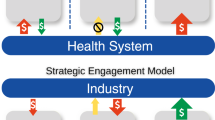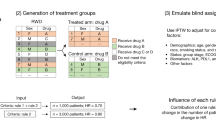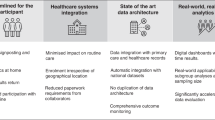Abstract
Medicine will move from a reactive to a proactive discipline over the next decade—a discipline that is predictive, personalized, preventive and participatory (P4). P4 medicine will be fueled by systems approaches to disease, emerging technologies and analytical tools. There will be two major challenges to achieving P4 medicine—technical and societal barriers—and the societal barriers will prove the most challenging. How do we bring patients, physicians and members of the health-care community into alignment with the enormous opportunities of P4 medicine? In part, this will be done by the creation of new types of strategic partnerships—between patients, large clinical centers, consortia of clinical centers and patient-advocate groups. For some clinical trials it will necessary to recruit very large numbers of patients—and one powerful approach to this challenge is the crowd-sourced recruitment of patients by bringing large clinical centers together with patient-advocate groups.
This is a preview of subscription content, access via your institution
Access options
Subscribe to this journal
Receive 12 print issues and online access
$209.00 per year
only $17.42 per issue
Buy this article
- Purchase on Springer Link
- Instant access to full article PDF
Prices may be subject to local taxes which are calculated during checkout
Similar content being viewed by others
References
Weston, A. D. & Hood, L. Systems biology, proteomics, and the future of health care: toward predictive, preventative, and personalized medicine. J. Proteome Res. 3, 179–196 (2004).
Hood, L. A. in Physical Biology: From Atoms to Medicine (ed. Zewail, A. H.) 337–366 (Imperial College Press, London, 2008).
Price, N. D. et al. in Essentials of Genomic and Personalized Medicine (eds Ginsburg, G. S. & Willard, H. F.) 131–141 (Elsevier Academic Press, Maryland Heights, 2009).
Auffray, C., Charron, D. & Hood, L. Predictive, preventive, personalized and participatory medicine: back to the future. Genome Med. 2, 57 (2010).
Zhao, L. Genomics: The tale of our other genome. Nature 465, 879–880 (2010).
Greenman, C. et al. Patterns of somatic mutation in human cancer genomes. Nature 446, 153–158 (2007).
Hwang, D. et al. A systems approach to prion disease. Mol. Syst. Biol. 5, 252 (2009).
Hood, L. & Galas, D. The digital code of DNA. Nature 421, 444–448 (2003).
Carey, L. A. Through a glass darkly: advances in understanding breast cancer biology, 2000–2010. Clin. Breast Cancer 10, 188–195 (2010).
Ivshina, A. V. et al. Genetic reclassification of histologic grade delineates new clinical subtypes of breast cancer. Cancer Res. 66, 10292–10301 (2006).
Piccart-Gebhart, M. J. et al. Trastuzumab after adjuvant chemotherapy in HER2-positive breast cancer. N. Engl. J. Med. 353, 1659–1672 (2005).
Schadt, E. E. et al. An integrative genomics approach to infer causal associations between gene expression and disease. Nat. Genet. 37, 710–717 (2005).
Cleator, S. & Ashworth, A. Molecular profiling of breast cancer: clinical implications. Br. J. Cancer 90, 1120–1124 (2004).
Monti, S. et al. Molecular profiling of diffuse large B-cell lymphoma identifies robust subtypes including one characterized by host inflammatory response. Blood 105, 1851–1861 (2005).
[No authors listed] Comprehensive genomic characterization defines human glioblastoma genes and core pathways. Nature 455, 1061–1068 (2008).
Hudson, T. J. et al. International network of cancer genome projects. Nature 464, 993–998 (2010).
Dalton, W. S. & Friend, S. H. Cancer biomarkers—an invitation to the table. Science 312, 1165–1168 (2006).
Marx, V. Merck–Moffitt personalized medicine partnership builds out information and data integration pipeline. GenomeWeb [online], http://www.genomeweb.com/informatics/merck-moffitt-personalized-medicine-partnership-builds-out-information-and-data- (2009).
Multiple Myeloma Research Foundation. Multiple Myeloma Research Consortium (MMRC) activates clinical trials 30–40 percent faster than industry standard. MMRFSM [online], http://www.themmrf.org/archive/outdated-content/press-releases-061809.html (2009).
Adenoid Cystic Carcinoma Research Foundation [online], http://www.accrf.org/ (2010).
Love, S. M., Mills, D., Eraklis, E. & Hulbert, M. The Love/Avon Army of Women: a “just in time” resource to encourage research in women [abstract]. J. Clin. Oncol. 27 (15 Suppl.), a1535 (2009).
Love/Avon Army of women [online], http://www.armyofwomen.org/ (2010).
Bouchie, A. Coming soon: a global grid for cancer research. Nat. Biotechnol. 22, 1071–1073 (2004).
Love/Avon. Health of women study [online], http://www.armyofwomen.org/HOW_Study (2010).
Mendelsohn, J., Tursz, T., Schilsky, R. L. & Lazar, V. Focus on personalized medicine: WIN Consortium—challenges and advances. Nat. Rev. Clin. Oncol. 8, 133–134 (2011).
Sonnenburg, S. et al. The need for open source software in machine learning. J. Mach. Learn. Res. 8, 2443–2466 (2007).
Author information
Authors and Affiliations
Contributions
Both authors contributed to researching the data for the article, discussion of content, and writing and reviewing the manuscript.
Corresponding author
Rights and permissions
About this article
Cite this article
Hood, L., Friend, S. Predictive, personalized, preventive, participatory (P4) cancer medicine. Nat Rev Clin Oncol 8, 184–187 (2011). https://doi.org/10.1038/nrclinonc.2010.227
Published:
Issue Date:
DOI: https://doi.org/10.1038/nrclinonc.2010.227
This article is cited by
-
Harnessing large language models (LLMs) for candidate gene prioritization and selection
Journal of Translational Medicine (2023)
-
Symptom-based stratification algorithm for heterogeneous symptoms of dry eye disease: a feasibility study
Eye (2023)
-
Classification of Ayurveda constitution types: a deep learning approach
Soft Computing (2023)
-
Will Big Data and personalized medicine do the gender dimension justice?
AI & SOCIETY (2023)



